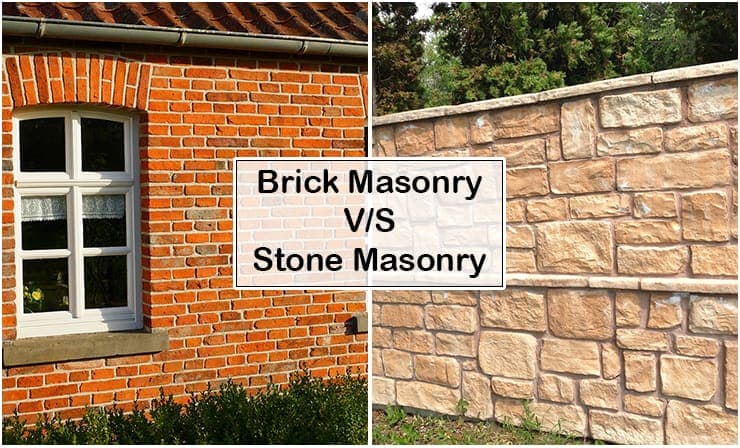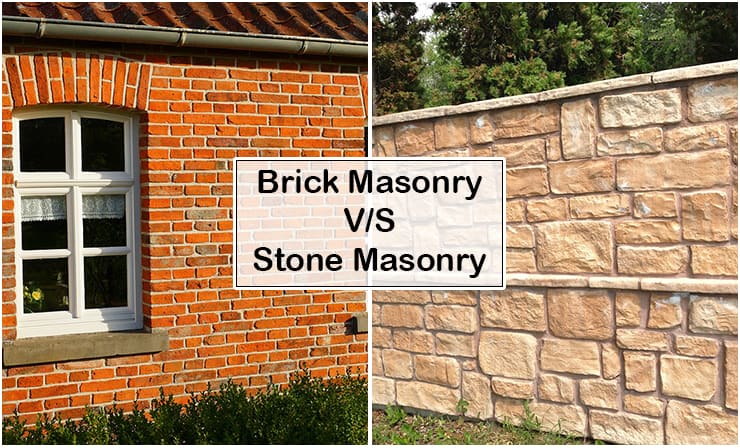
Masonry is one of the oldest methods of construction known to humans. Every country in the world has unique and important structures that stand up because they were built of masonry. Masonry buildings particularly stone masonry are immensely durable to weather and not easily damaged by physical or environmental forces. Reinforced masonry also resists seismic forces and the hurricane.
Masonry is the process of laying down one masonry unit i.e. bricks and stones, concrete blocks etc. over another with mortar in a uniform manner to construct a member or an element of the building.
Both brick and stone masonry give a beautiful and timeless look, but is one necessarily “better” than the other? That’s hard to say, as both materials have their pros and cons.
Here, we have discussed differences between brick and stone masonry.

01. Life
- From times immemorial, stone has been used both for residential as well as public buildings. Historical buildings that stand today are the living examples of the durability, strength and the excellent weather-resisting qualities of stone masonry.
- Life of stone masonry is more as compared to brick masonry and if it done properly it will be more than 100/2000 years.
- Brick on other hand has much less strength, durability and weather-resisting qualities.
- Life of brick masonry is less as compared to stone masonry.
02. Strength
- On account of its high crushing strength stone is used in the construction of piers, docks, dams, and other marine structure.
- Stones are not in regular shape hence it is difficult to obtain proper bond in stone masonry and hence less strength.
- Dead load of stone masonry is more.
Also Read: Know All About Stone Masonry
- Bricks, on the other hand, are not considered suitable in all such places.
- Bricks are uniform and regular in shape therefore; proper bond can be easily obtained and hence better strength.
- Dead load of brick masonry is less.
Also Read: All About Brick Masonry Construction and Its Precautions
03. Aesthetic
- Shinning texture of good class of stone masonry requires no treatment to enhance its appearance.
- In buildings of monumental nature where architecture requires heavy moldings with large projections, stone is best suited.
- It is difficult to get desired shape of stone.
- Stone masonry can have different colors depending upon the stones used.
- More options are available for design variation as stone comes in wider variety of shapes, size, and tones.
- Stone masonry gives more aesthetic look.
- While, plaster is required to conceal the defects in brick masonry, or poor quality of bricks.
- Brick is suitable for light ornamental work only.
- Bricks can be easily molded into any desired shape at reasonable cost.
- Generally, brick masonry is in red color.
- Less options are available for design variation as bricks come in standard size and same color
- Less aesthetic appeal with brick as there are limited sizes and colors.
04. Effect of Environment
- Stones when exposed, do not get damp.
- Stones can be used in sewage without providing any protective coat.
- Stone masonry is less fire resisting as compared to brick masonry
- Stone walls emit more quantity of heat and make sitting in the room uncomfortable.
- Stone masonry is good insulation to air-transmitted noise.
Also Read: Types of Stone Masonry – Choose Wisely for your House Construction!
- Bricks when exposed are liable to get damp. Dampness may ultimately lead to the disintegration of the masonry and other components of building.
- Certain salts present in the sewage react chemically with exposed brick and as such when brick-work happens to come with sewage, it always need to be plastered, otherwise it will deteriorate.
- Brick masonry is more fire resisting as compared to stone masonry.
- Bricks absorb less quantity of heat.
- Brick masonry has low insulation to air-transmitted noise.
Also Read: Stone Masonry Construction: 40+ Various Guidelines to Keep in Mind!
05. Cost
- The usage of stone is generally restricted to hilly areas where stones are locally available easily.
- The masonry constructed with stones cost more if it is away from sources.
- Stones are large in size; hence the minimum thickness of a stone wall is generally greater than 35 cm (14”).
- Mortar joints are thick in stone masonry and hence it requires more mortar.
- Bricks are easily available almost at all places except hilly and rocky areas.
- The masonry constructed with bricks costs much less.
- Bricks walls can be easily built in small thickness of even 13 cm, 23 cm and so on.
- Mortar joints are thin in brick masonry and hence it requires less mortar.
06. Overall
- Due to heavy weight, large size of unit, thicker walls, need of skilled labor, it becomes costly sometimes and hence not preferred nowadays.
Also Read: What are the Pros and Cons of Masonry in Construction?
- First class bricks give all such qualities which are required for a good construction and hence brick masonry has now practically replaced stone masonry.
Also Read: Types of Masonry that can be Used for Construction of your Dream Home
07. Workmanship
- Stone masonry proceeds slowly because handling of stone is not easy.
- In stone masonry the process of dressing and placing stones requires a great deal of time and extra labor.
- Skilled labors are required for good stone masonry construction because the defects left by a careless mason cannot be rectified easily.
- In stone masonry, the large size of stone has to be kept in position which require some lifting device.
- Stone is not only heavy and hard to install but quite dangerous. Sometime, serious incidents may happen where joints inside the interior wall have deteriorated due to a lack of drainage for moisture which led to the overall collapse of the stone masonry structure.
- Brick masonry proceeds very quickly because bricks are handy.
- On account of their regular size and shape, bricks afford great facility in maintaining proper bond in the brick masonry. It also results in quick construction.
- While in brick masonry the defects of a careless bricklayer can be easily rectified and also can be concealed by plastering.
- Due to their convenient size and light weight, bricks don’t require lifting tackle.
- Bricks are light in weight, hence it’s easy to handle hence, there is no risk of serious incident.
08. Utility
- The high thickness of the walls leads to a low yield of the potential living area i.e. less carpet area efficiency.
- The thickness of brick wall is less, which gives more carpet area.
09. Flexibility
- Openings for doors, windows, jambs are quite difficult in stone masonry, as they need to be cut to different sizes.
- Stone masonry is difficult to repair or relocate.
- Stone masonry cannot be easily altered.
- For the construction of jambs of doors and windows and for the walls meeting at obtuse or acute angle, bricks offer greater facility than stone.
- Brick masonry is easy to repair or relocate.
- Brick masonry cab be easily altered.
According to local availability of masonry unit; one can use stone or brick as masonry material for building. Generally, stone masonry is preferred in an area where stones are locally available. In the area where stones are not available locally, the cost of stone masonry will be more. Generally, brick masonry is preferred in area where clay for bricks is easily available. Hope, this difference between brick and stone masonry will give you clear idea about which to be choose.
Must Read:
Difference Between Concrete and Cement
Difference between Reinforced Concrete & Steel Framed Structure































